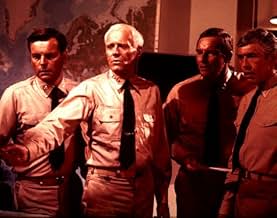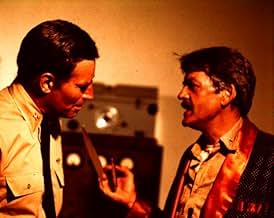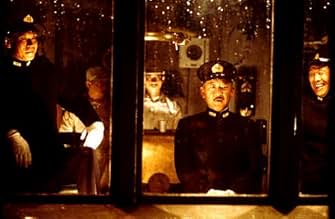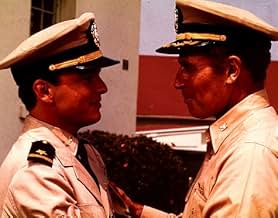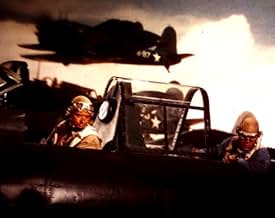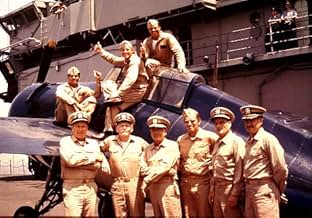VALUTAZIONE IMDb
6,8/10
22.549
LA TUA VALUTAZIONE
Erano trascorsi soltanto sei mesi da Pearl Harbour quando, nel giugno del 1942, esplose la battaglia che si sarebbe rivelata il momento cruciale degli scontri nel Pacifico.Erano trascorsi soltanto sei mesi da Pearl Harbour quando, nel giugno del 1942, esplose la battaglia che si sarebbe rivelata il momento cruciale degli scontri nel Pacifico.Erano trascorsi soltanto sei mesi da Pearl Harbour quando, nel giugno del 1942, esplose la battaglia che si sarebbe rivelata il momento cruciale degli scontri nel Pacifico.
- Regia
- Sceneggiatura
- Star
Toshirô Mifune
- Admiral Isoroku Yamamoto
- (as Toshiro Mifune)
Recensioni in evidenza
Saturday night TV is a bit of a dead zone down here so I suppose one should be grateful for the odd watchable movie, even if its 20 years old. This one looks older than it actually is, due to the liberal use of stock footage and a cast that's a retirement counsellor's dream. A relatively youthful Charlton Heston is in the lead, but there's Henry Fonda, Glenn Ford, Robert Mitchum, Robert Webber and even the great Japanese actor Toshiro Mifune. A curious aspect is that every military character with a speaking part is an officer; the grunts just get to grunt. It's very much the view from the bridge (and the pilot's seat). Despite this aspect and the attempt at historical realism it's not made clear quite how it was that the Japanese made the error that cost them the battle, getting caught with their flightdecks full just as the American torpedo bombers arrived. The contribution of the American land-based aircraft is also given scant recognition.
Still you do get a bit of a story, though the less said about the silly sub-plot involving the Heston character's son and a Japanese-American girl the better. The director, Jack Smight had extensive T V experience, as did many of the younger actors, and this shows up in the rather static dialogue scenes you get when you aren't allowed to move the cameras much. The Japanese voices are dubbed, so that Paul Free, the voice of Boris Badenov in "Bullwinkle," (and countless other cartoon characters) is Admiral Yamamoto. The music was written by John Williams who a year or so later did the music for "Star Wars" and you can sense the similarities.
In the film the military operations side of things abounds with anacronisms, partly due to the liberal use of stock footage as mentioned. I don't think you can be too hard on the producers (the low profile but financially successful Mirisch Brothers) for not using a real Japanese World War 2 aircraft carrier since they are all at the bottom of the sea, but the crashed jet on the Yorktown's flightdeck was a bit sloppy. "Tora Tora Tora," which cost more money, was a better film. Not because it cost more money but because it was more carefully made, more balanced (both side's story told well) and more honest, perhaps also because it dealt with defeat rather than victory from the American viewpoint. "Midway" has some suspense, plenty of action, and the the patriotism drum is not banged to the point of pain.
Still you do get a bit of a story, though the less said about the silly sub-plot involving the Heston character's son and a Japanese-American girl the better. The director, Jack Smight had extensive T V experience, as did many of the younger actors, and this shows up in the rather static dialogue scenes you get when you aren't allowed to move the cameras much. The Japanese voices are dubbed, so that Paul Free, the voice of Boris Badenov in "Bullwinkle," (and countless other cartoon characters) is Admiral Yamamoto. The music was written by John Williams who a year or so later did the music for "Star Wars" and you can sense the similarities.
In the film the military operations side of things abounds with anacronisms, partly due to the liberal use of stock footage as mentioned. I don't think you can be too hard on the producers (the low profile but financially successful Mirisch Brothers) for not using a real Japanese World War 2 aircraft carrier since they are all at the bottom of the sea, but the crashed jet on the Yorktown's flightdeck was a bit sloppy. "Tora Tora Tora," which cost more money, was a better film. Not because it cost more money but because it was more carefully made, more balanced (both side's story told well) and more honest, perhaps also because it dealt with defeat rather than victory from the American viewpoint. "Midway" has some suspense, plenty of action, and the the patriotism drum is not banged to the point of pain.
I remember reading that this movie was made primarily because they had excessive footage from when they shot "Tora! Tora! Tora! and some of the shot looks like they did came from that film. But this film also includes old actual shots taken by service men and news people.
The movie is based on the American victory off Midway Island. The movie was made 30 years after WWII and a couple of years after Vietnam, so it doesn't have a jingoistic feel to it. It has more of a matter of fact feel to it, more a docudrama than propaganda.
The movie is different from most war movies because it shows how Grand battles are won and lost. There isn't much individual heroism from ordinary soldiers shown. Instead we see how commanders, in this case admirals make decisions and take risks usually based on sketchy information. They put their reputations on line, along with the safety of their men, and the security of their nations. We see how the outcome of a battle can hinged on risky decisions or sometimes on indecision. We see how commanders have to sweat out their decisions as History hangs on the balance. Yes! History! This battle after all is considered the turning point of the War in the Pacific.
In this movie decisions are made on what certain letters mean, whether enemy carriers are where they are supposed to be. If viewers give it the appropriate attention, they will see that this movie plays like a giant chess match. The outcome determined by gutsy moves and bad decisions, sometimes indecision.
The movie boasts an impressive cast which include, Henry Fonda, Glenn Ford, Robert Mitchum, Cliff Robertson, Charlton Heston and they all do fine jobs. They play the typical Grand characters in epic movies, they move the story along but has no personal stories themselves. The one personal story belongs to Edward Albert, who plays Heston's son. He's not very convincing and playing opposite a pro like Mr. Heston, he comes across as being weak almost amateurish.
The movie is good but far from great. I love how the filmmakers remained true to the events. But the special effects looked cheap and the use of actual combat footage feels inappropriate and even exploitive. Nevertheless I think it's a good film not to be missed by Military History buffs.
The movie is based on the American victory off Midway Island. The movie was made 30 years after WWII and a couple of years after Vietnam, so it doesn't have a jingoistic feel to it. It has more of a matter of fact feel to it, more a docudrama than propaganda.
The movie is different from most war movies because it shows how Grand battles are won and lost. There isn't much individual heroism from ordinary soldiers shown. Instead we see how commanders, in this case admirals make decisions and take risks usually based on sketchy information. They put their reputations on line, along with the safety of their men, and the security of their nations. We see how the outcome of a battle can hinged on risky decisions or sometimes on indecision. We see how commanders have to sweat out their decisions as History hangs on the balance. Yes! History! This battle after all is considered the turning point of the War in the Pacific.
In this movie decisions are made on what certain letters mean, whether enemy carriers are where they are supposed to be. If viewers give it the appropriate attention, they will see that this movie plays like a giant chess match. The outcome determined by gutsy moves and bad decisions, sometimes indecision.
The movie boasts an impressive cast which include, Henry Fonda, Glenn Ford, Robert Mitchum, Cliff Robertson, Charlton Heston and they all do fine jobs. They play the typical Grand characters in epic movies, they move the story along but has no personal stories themselves. The one personal story belongs to Edward Albert, who plays Heston's son. He's not very convincing and playing opposite a pro like Mr. Heston, he comes across as being weak almost amateurish.
The movie is good but far from great. I love how the filmmakers remained true to the events. But the special effects looked cheap and the use of actual combat footage feels inappropriate and even exploitive. Nevertheless I think it's a good film not to be missed by Military History buffs.
The film Midway shows in graphic documentary style, the battle that did nothing less than save America and ultimately allow us to win World War II. If the Japanese had prevailed at Midway, they might very well have taken Hawaii and been blockading our continental Pacific coast. We might have had to declare a truce and hope that public opinion would allow us to continue the European and North African war. Remember the USA was brought in to the war because of the Japanese attack at Pearl Harbor, not Hitler's attack.
There is a plot of sorts with Charlton Heston as the fictional pilot group commander who's involved in helping his son Edward Albert help a Nisei family who've been interred for the duration of the war because Albert is engaged to the daughter. That's the one weakness of Midway, the story really wasn't necessary and detracted with the very precise telling of the Midway tale. Had they left it out, Midway had the potential to be a classic like The Longest Day.
Without Charlton Heston and his family problems, the story of Midway is told with remarkable historic accuracy. Henry Fonda who played Admiral Chester W. Nimitz in all but name in In Harm's Way, gets to play Nimitz again in Midway. Robert Mitchum and Glenn Ford play Admirals William Halsey and Raymond Spruance who between the two of them won America's Pacific war. A whole lot of fine character actors like James Coburn, Robert Wagner, Robert Webber, Hal Holbrook and many more fill their naval roles to precision.
The story of the Battle of Midway should be told and told again in America's public schools for future generations. Not just because of the sailors and airmen of America's greatest generation who fought and prevailed at Midway, but because of just how close a run thing the Battle of Midway was. One very fateful decision by Admirals Yamamoto and Nagumo turned the tide of battle on a dime. By the way the oriental players in Midway like Toshiro Mifune as Yamamoto and James Shigeta as Nagumo and others also play very well. The American cinema certainly came a long way from when they previously cast the Japanese as bucktooth primates.
When the viewer sees just how much pure luck played a part in winning at Midway, they will come away with one of two impressions. The first might be that a divine providence is guiding and protecting America. If so, who's to say that will always be the case. And if not, the second lesson might be that we as a country might not always be so lucky.
If they could edit out the Heston family story, Midway is a great film for history classes studying World War II.
There is a plot of sorts with Charlton Heston as the fictional pilot group commander who's involved in helping his son Edward Albert help a Nisei family who've been interred for the duration of the war because Albert is engaged to the daughter. That's the one weakness of Midway, the story really wasn't necessary and detracted with the very precise telling of the Midway tale. Had they left it out, Midway had the potential to be a classic like The Longest Day.
Without Charlton Heston and his family problems, the story of Midway is told with remarkable historic accuracy. Henry Fonda who played Admiral Chester W. Nimitz in all but name in In Harm's Way, gets to play Nimitz again in Midway. Robert Mitchum and Glenn Ford play Admirals William Halsey and Raymond Spruance who between the two of them won America's Pacific war. A whole lot of fine character actors like James Coburn, Robert Wagner, Robert Webber, Hal Holbrook and many more fill their naval roles to precision.
The story of the Battle of Midway should be told and told again in America's public schools for future generations. Not just because of the sailors and airmen of America's greatest generation who fought and prevailed at Midway, but because of just how close a run thing the Battle of Midway was. One very fateful decision by Admirals Yamamoto and Nagumo turned the tide of battle on a dime. By the way the oriental players in Midway like Toshiro Mifune as Yamamoto and James Shigeta as Nagumo and others also play very well. The American cinema certainly came a long way from when they previously cast the Japanese as bucktooth primates.
When the viewer sees just how much pure luck played a part in winning at Midway, they will come away with one of two impressions. The first might be that a divine providence is guiding and protecting America. If so, who's to say that will always be the case. And if not, the second lesson might be that we as a country might not always be so lucky.
If they could edit out the Heston family story, Midway is a great film for history classes studying World War II.
I first saw this movie when it was opening as a 10 year old boy who was enamored with WWII. At that time to me, it was one of the best war movies I had ever seen. Due to my prior readings on the battle, I knew it followed the history fairly well, and I was able to tune out the romance sub plot. The look of movie was something that was something I was not familiar with in war movies up to that point. The indoor officers were in nice neat uniforms, while the pilots, Marines, and common sailors had a weary rumpled look. And the language! I had not yet heard so much cursing in a war movie (it was 1976 and for the most part John Wayne type movies were the norm). But I loved it all! I knew most of the planes shown on screen were not accurate, and much of the combat footage was from later in the war. But it showed a different type of war movie. The Japanese were strong, smart, and nearly invincible. Not monsters or maniacs, but allowing overconfidence at times to cloud some decisions. The Americans were brave, novices, unsure of themselves at times, yet determined not to fail, no matter the cost. Not the overpowering unbeatable force of years to come later in the war. Watching during the initial phases of combat as obsolete US planes were shot down one by one by the superior Japanese fighters, I was captivated by the self sacrifice(a year later the ending dogfight in Star Wars would make me think of Torpedo 8). Then the tide turned as events, luck, and timing change the course of battle. In the end, the US wins, the Japanese are defeated, and survivors ponder the results and reasons why briefly. Flash forward 32 years later and I watch this movie again on my DVD copy on the 66th anniversary of the battle. This movie holds up not too badly against the test of time. Much time has passed in by movie making and in my gaining knowledge of this subject. To me the strengths still hold, as do the weaknesses. The interracial romance subplot is certainly a 70s addition. Certainly not believable in a historical context. The stock footage of aircraft certainly still glares in error as well. Color footage was shot during the battle and released in a documentary. A small amount was incorporated into the movie. Much more could have replaced other sequences that were used in the movie. Many of the Tora!Tora!Tora! conversion aircraft were still local to Universal Studios at Orange County or Chino airports at the time of filming. Some were used in the Midway Island bombing sequence, but not in the Yorktown attacks. Too bad they did not make more use of them for a better look. The Japanese film sequences from "Storm Over the Pacific" actually worked very well for their capturing the look of the Japanese carriers and the activities on board. As did the lifted opening from "30 seconds Over Tokyo". Much of the dialog on film is true to life with certain quotes historically accurate. "Look at that b*****d burn", was the first radio message clearly heard on the US carriers letting them know any of the air strikes had made contact and been successful. It also holds up sticking fairly close to the time line of actual events, but there are several events omitted. Finally the effects were not bad. For pre CGI the choices are to build full scale mocks ups, use an area or item that has a resemblance or miniatures. All three methods were used to good effect. And the results were for the most part just as good as, if not better than the more modern (film making wise) CGI heavy "Pearl Harbor". All in all, a decent war movie, still worth watching, flaws and all.
Of course "Midway" is a flawed movie. The subplot about Japanese-Americans is ridiculous and seems like a forced attempt to be PC during the post-Vietnam 1970s when it wasn't in fashion to be completely celebratory of America. Of course it's unsatisfying that the Japanese actors don't speak Japanese and we have to hear Paul Frees dubbing Toshiro Mifune. Of course the stock footage isn't going to please aviation and naval buffs who know these details like the back of their hands, but to me this is a trivial complaint that fails to take into account the limits of 1970s technology or budgeting. "Pearl Harbor" ultimately got those details right through CGI and the end result was a far worse film in the final analysis. Because ultimately, for all the flaws that are in "Midway" it succeeds because it does stick to the essential truths when telling the story of the battle, and I know this because when I first saw this movie on the CBS Late Movie around 1979, I got so hooked that I went out and read every book on the battle I could find including Walter Lord's "Incredible Victory." The movie had given me a starting reference point and while I was sorry that some key aspects of the latter stages of the battle were not depicted (such as the torpedoing and eventual sinking of the Yorktown), I couldn't have asked for anything better in terms of getting me to learn more about this great turning point of World War II. As far as I'm concerned, it's good that Hollywood did tackle this subject in an era when the influence of "Tora! Tora! Tora!", "The Longest Day" etc. still hung over the proceedings because if it hadn't been made back then, we would today be forced to see it given the "Pearl Harbor" and "Titanic" treatment that is pure garbage.
John Williams contributes one of his finer pre-Star Wars scores with two great themes, the "Midway March" (which is only heard in the end credits of the theatrical version and became more popular in an expanded concert arrangement by the Boston Pops) and the "Men Of The Yorktown March" which dominates much of the score and offers great foreshadowings of the Throne Room sequence in "Star Wars" and the Smallville music in "Superman."
John Williams contributes one of his finer pre-Star Wars scores with two great themes, the "Midway March" (which is only heard in the end credits of the theatrical version and became more popular in an expanded concert arrangement by the Boston Pops) and the "Men Of The Yorktown March" which dominates much of the score and offers great foreshadowings of the Throne Room sequence in "Star Wars" and the Smallville music in "Superman."
Lo sapevi?
- QuizKevin Dobson's character Ensign George Gay, was the sole survivor of Torpedo Squadron 8. Gay wrote a book about his experiences (Sole Survivor) and was an advisor on this film.
- BlooperWhen the cockpit of one of the planes catches fire, the pilot pulls out a fire extinguisher. It is a more modern one, not a fire extinguisher that would have existed in the 1940s.
- Citazioni
Vice Adm. Chuichi Nagumo: [commenting on the American torpedo bombers] They sacrifice themselves like samurai, these Americans.
- Versioni alternativeA television version exists, with additional cast and plot. It runs four hours with commercials. The main plot points are a Charlton Heston-Susan Sullivan romance and the Coral Sea battle (referred to in the other version) is played out like the Midway battle. The Coral Sea battle heavily features Mitchell Ryan as Admiral Aubrey Fitch and also includes a subplot where a young Japanese pilot who'd met with Admiral Nagumo to express his opposition to Japanese military action is shot down. At the end of the TV version, Sullivan and Christine Kukobo are both shown waiting dockside.
- ConnessioniEdited from Il difensore di Manila (1943)
- Colonne sonoreIn the Mood
Music by Joe Garland
Performed by the Glenn Miller and His Orchestra (as Glenn Miller Orchestra) on the jukebox at the bar in Hawaii
I più visti
Accedi per valutare e creare un elenco di titoli salvati per ottenere consigli personalizzati
- How long is Midway?Powered by Alexa
Dettagli
Botteghino
- Lordo Stati Uniti e Canada
- 43.220.000 USD
- Fine settimana di apertura Stati Uniti e Canada
- 4.356.666 USD
- 20 giu 1976
- Tempo di esecuzione2 ore 12 minuti
- Colore
- Proporzioni
- 2.39 : 1
Contribuisci a questa pagina
Suggerisci una modifica o aggiungi i contenuti mancanti

Divario superiore
By what name was La battaglia di Midway (1976) officially released in India in English?
Rispondi

